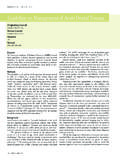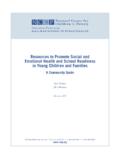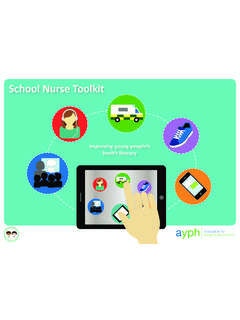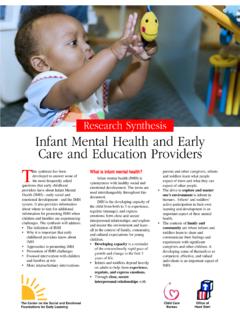Transcription of Policy on Oral Health Care Programs for Infants, …
1 AMERICAN ACADEMY OF PEDIATRIC DENTISTRYORAL Health POLICIES 27 PurposeThe American Academy of Pediatric Dentistry (AAPD) rec-ognizes the importance of education, prevention, diagnosis, and treatment necessary to maintain the oral Health of infants, children, and adolescents through preventive and restorative care . Comprehensive Health care cannot be achieved unless oral care is included in all Health service Programs . Methods This Policy was originally developed by the Dental care Programs Committee and adopted in 1972.
2 This docu-ment is an update of the previous version, revised in 2012. This revision is based upon a review of current publica- tions and Websites of governmental agencies and Health care organizations. A PubMed /MEDLINE search was performed using the terms: oral Health Policy , infant oral Health Policy , child oral Health Policy , adolescent oral Health Policy ; fields: all; limits: within the last 10 years, humans, English, birth through age 18. Thirteen articles matched these criteria. Papers for review were chosen from this list and from references within selected The Department of Health and Human Services (HSS)
3 Reports that caries is the most prevalent infectious disease in our nation s More than 40 percent of children have caries by the time they reach In contrast to declining prevalence of dental caries among children in older age groups, the prevalence of caries in poor children under the age of five is The prevalence of caries within the two to five year old age group among higher income families is 18 percent, while that of children from low-income families was 42 ,5 Disparities in caries prevalence exists within specific population subgroups in the Untreated caries among children 2-8 years of age was shown to be twice as high for Hispanic and non-Hispanic African American children in comparison to non-Hispanic white American Indian (AI) and Alaska native (AN)
4 Children demonstrated a higher rate of caries than other population groups in the , with approximately 40 percent of AI/AN children aged between 1-5 years exhibiting untreated caries in contrast to only 11 percent of non-Hispanic white HHS documents there exists a perception that oral Health is separate from general Health and, therefore, less important. By raising oral Health awareness, the prevention, early detec- tion, and management of dental, oral, and craniofacial tissues can become integrated into Health care , community-based pro-grams, and social HHS recognizes that oral Health can have a significant impact on overall Health and well-being.
5 Major themes of the Surgeon General s report on Oral Health in America 1 include: Oral Health means much more than healthy teeth. Oral Health is integral to general Health . Accordingly, the HHS report National Call to Action to Promote Oral Health 10 recommended: Changing perceptions of the public, policymakers, and Health providers regarding oral Health and disease so that oral Health becomes an accepted component of gen- eral Health . Removing known barriers between people and oral Health services. Accelerating the building of the scientific and evidence base, as well as the application of research findings, to improve oral Health .
6 Ensuring the adequacy of public and private Health per- sonnel and resources to meet the oral Health needs of all Americans and enable the integration of oral Health effectively with general Health . The focus is on having a responsive, competent, diverse, and flexible workforce. Expanding public-private partnerships and building upon common goals to improve the oral Health of those who suffer disproportionately from oral follow-up to Oral Health in America 1, the HHS Oral Health Initiative 2010 was The key statement from this initiative was, Oral Health is integral to overall Health .
7 11 Nine new activities promoting oral Health were de- signated to agencies under the governance of the HHS. Review CouncilCouncil on Clinical AffairsLatest Revision2016 Policy on Oral Health care Programs for Infants, Children, and AdolescentsABBREVIATIONS AAPD: American Academy Pediatric Dentistry. AI: Alaskan In-dian. AN: Alaska native. HSS: Health and Human Services. IOM: Institute of ORAL Health POLICIES AMA AERAICNEDNYIIIIIOIFPITIESILIIIIIH2 ITIH7 Through this initiative, Programs were created, produced, and financed to:11 Emphasize oral Health promotion and disease prevention.
8 Increase access to care . Enhance oral Health workforce. Eliminate oral Health 2009, the Health Resources and Services Administration requested the Institute of Medicine (IOM) evaluate the current oral Health system for the entire population and provide recommendations and strategic approaches to the HHS for a potential oral Health initiative. Reviewing important factors such as care settings, workforce, financing, quality assessments, access to care , and education, the IOM committee focused on these areas and how these factors linked to current and future HHS Programs and The committee report, Advanc-ing Oral Health in America 12, provided recommendations/ organizing principles for a new oral Health initiative: Establish HHS high-level accountability in evaluating the oral Health initiative.
9 Focusing on disease prevention and oral Health pro- motion. Improving oral Health literacy and cultural competence. Reducing oral Health disparities. Enhancing the delivery of oral Health care . Enhance the role of non-dental Health care professionals. Expand oral Health research and improve data collection. Promote collaboration among private and public stake- holders. Measure progress toward short-term and long-term goals and objectives. Advance the goals and objectives of Healthy People statement The AAPD advocates that oral Health care must be included in the design and provision of individual, community-based, and national Health care Programs to achieve comprehensive Health care .
10 This can be achieved through the recommenda- tions of the HHS reports National Call to Action to Promote Oral Health 10 and Oral Health Initiative 2010 11 and the IOM report Advancing Oral Health in America 1. Dept of Health and Human Services. Oral Health in America: A Report of the Surgeon General. Rockville, Md.: Dept of Health and Human Services, National Institute of Dental and Craniofacial Research, National Institutes of Health ; 2000. 2. Pierce KM, Rozier RG, Vann WF Jr. Accuracy of pedi- atric care providers screening and referral for early child- hood caries.

















